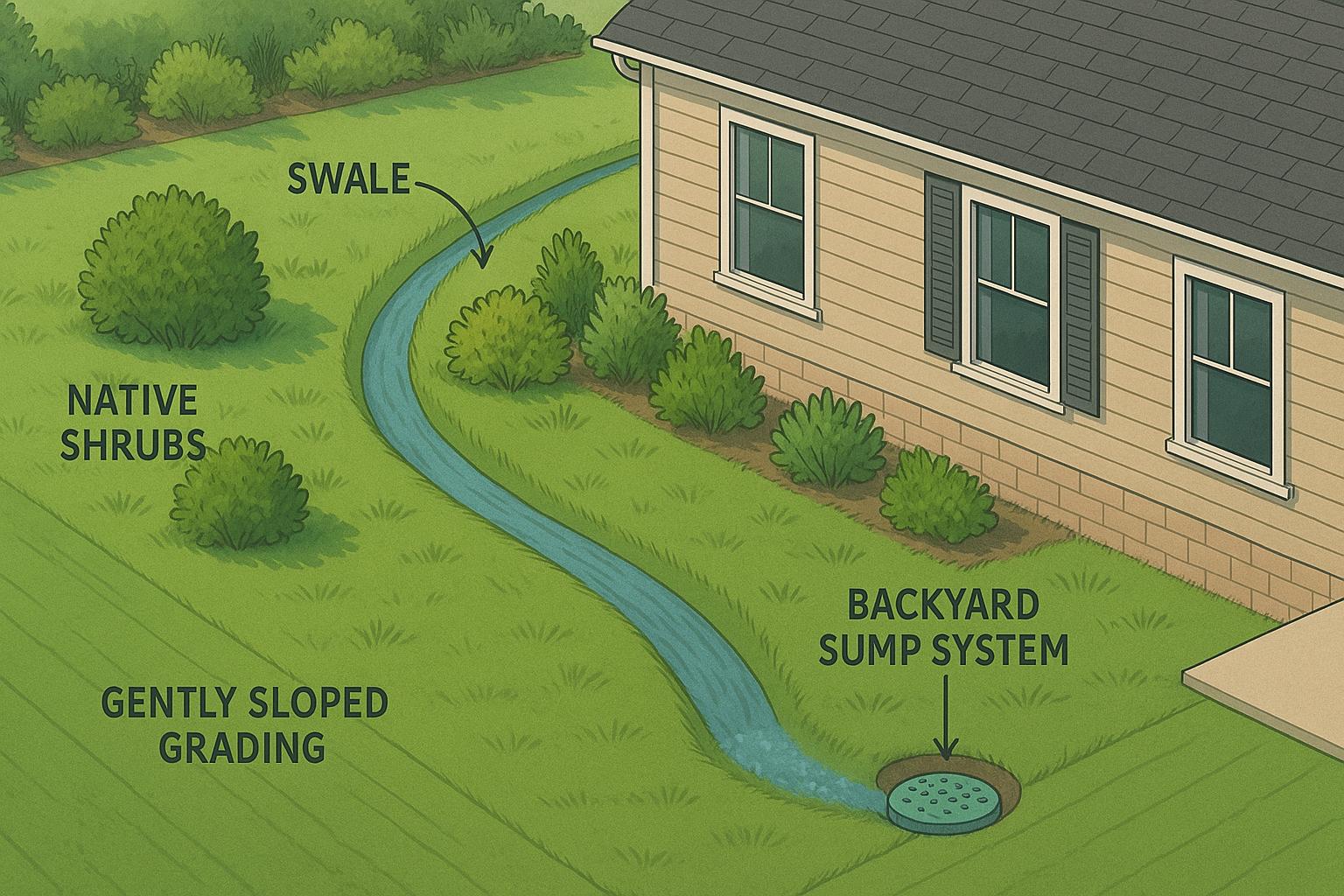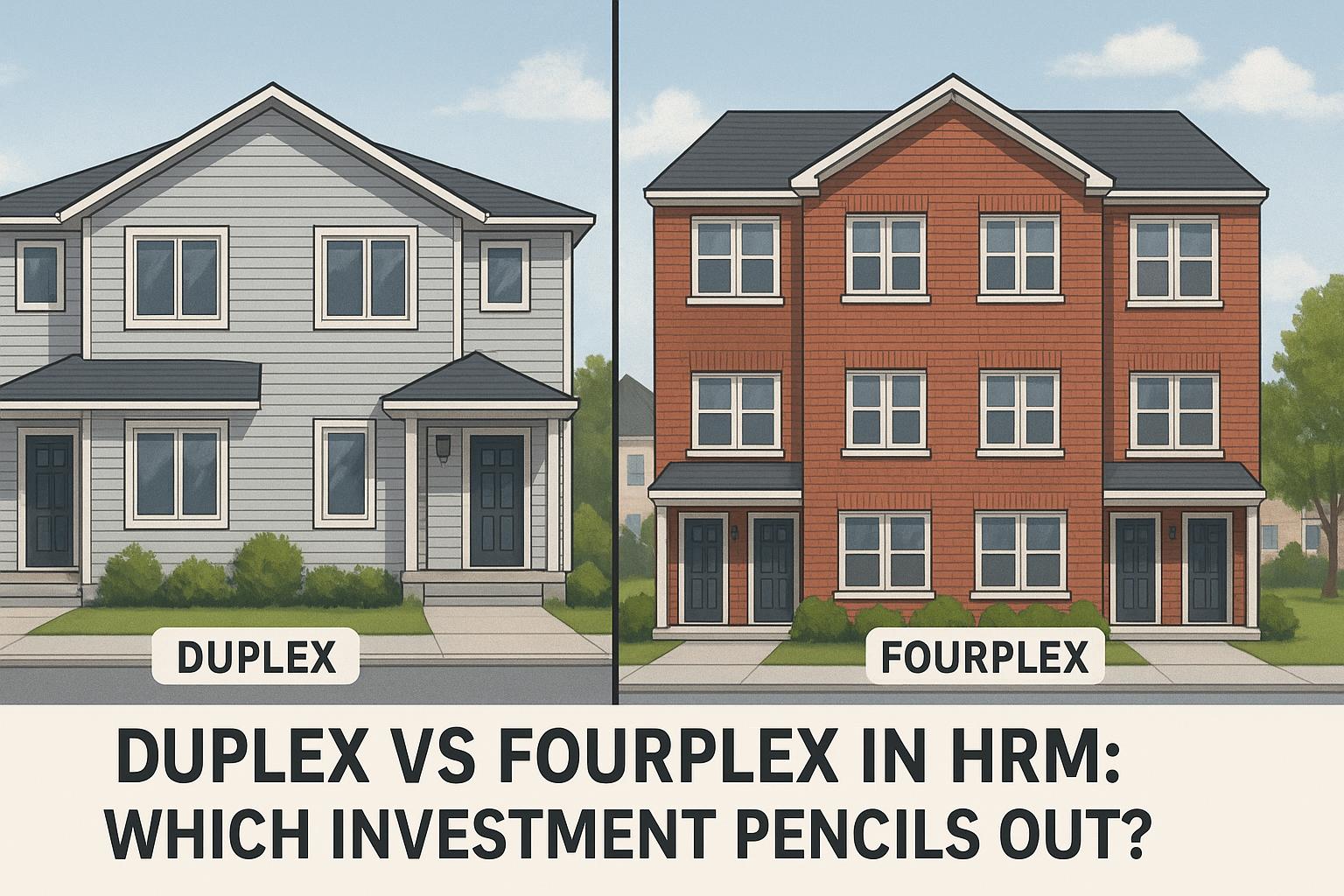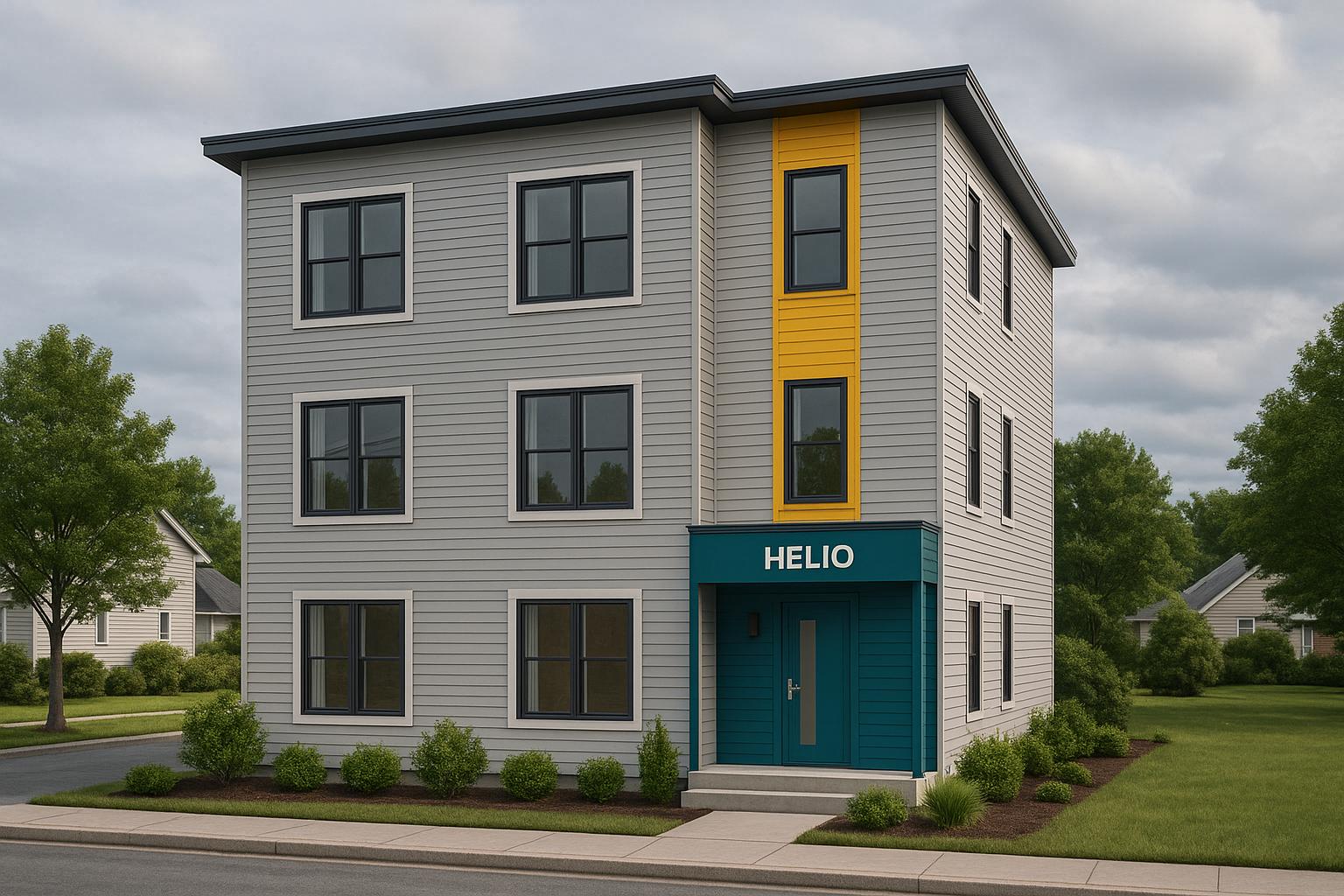If you're deciding whether to build new or buy existing multi-unit rentals in Nova Scotia, here's the bottom line: building new often offers better financial control, higher rental income, and lower long-term risks. However, buying existing properties provides immediate rental income but might come with hidden expenses like maintenance or renovations.
Key considerations include:
- Cost: Building new costs around $160,000 per unit with predictable pricing, while buying existing properties can involve additional renovation costs.
- Timeline: New construction (with integrated builders) can be completed in 6 months, but delays in fragmented projects or renovations for existing properties can stretch timelines.
- Rental Income: New units with modern features can command rents of $1,950–$2,100/month, whereas outdated properties may struggle to attract top-tier rents.
- Financing: CMHC offers 95% financing and 50-year amortization for new builds, making them more cash-flow friendly compared to conventional financing for existing properties.
- Risk: New builds come with warranties and energy-efficient designs, reducing maintenance and operating costs. Existing properties may require costly retrofits and have no warranty.
Quick Comparison:
| Factor | Building New | Buying Existing |
|---|---|---|
| Cost | $160,000/unit (fixed pricing) | Renovations may increase total cost |
| Timeline | 6 months with integrated builders | Immediate income, but delays likely |
| Rental Income | $1,950–$2,100/month | Limited by outdated features |
| Energy Efficiency | Built-in modern systems | Expensive retrofits needed |
| Financing | 95% CMHC financing, 50-year term | Conventional financing required |
| Risk | Warranties, predictable timelines | Hidden maintenance costs |
While both options have pros and cons, building new stands out for investors prioritizing predictable costs, modern amenities, and long-term ROI.
Nova Scotia Effectively Removes HST on New Rental Housing Development
1. Building New Multi-Unit Rentals
Constructing new multi-unit rentals in Nova Scotia offers a unique opportunity to shape the design and functionality of your property. The success of your project often hinges on whether you choose a fragmented approach - hiring separate contractors and professionals - or opt for an integrated system that simplifies coordination and execution.
Cost Comparison
In Nova Scotia, working with an integrated builder typically costs around $160,000 per unit. This price includes features that not only attract tenants but also help reduce ongoing maintenance expenses.
On the other hand, a fragmented approach - where you hire individual architects, engineers, and contractors - can lead to inefficiencies. These inefficiencies, often caused by miscommunication or unexpected design changes, can add roughly $47,000 in extra costs per fourplex.
For those considering the CMHC MLI Select financing option, a unit priced at $200,000 qualifies for 95% financing with only 5% down. This option also includes benefits like 40% improved energy efficiency and a 50-year amortization period, enabling immediate positive cash flow.
Timeline and Risk
The length of your construction timeline directly affects your return on investment, as delays mean lost rental income. A fragmented approach often extends timelines from the usual 8 months to 18+ months, largely due to scheduling conflicts among multiple professionals.
Integrated builders, like Helio Urban Development, address this issue with streamlined scheduling. They promise a 6-month construction timeline and even impose financial penalties of up to $1,000 per day for delays, ensuring your project stays on track and rental income starts as planned.
Shorter and more predictable timelines mean you can begin earning rental income sooner, maximizing your investment.
Rental Income Potential
New builds give you the flexibility to design units that appeal to renters and boost income. For example, modern two-bedroom units equipped with features like keyless entry and programmable thermostats can command monthly rents between $1,950 and $2,100 in Nova Scotia’s rental market.
Market-Specific Opportunities
Taking an integrated approach aligns your property with market demands and evolving regulations. Energy-efficient, purpose-built rentals are better prepared to meet regulatory standards, avoiding costly retrofits down the road. Additionally, building within a 90-minute radius of Halifax allows you to tap into the strong urban rental demand while taking advantage of lower land costs in surrounding areas.
For those aiming to hit the ground running, the Premium Rental Ready Package - priced at $15,000 per unit - includes a full suite of appliances and smart home features. This package not only enables immediate rental readiness but also saves over $3,000 per unit through bulk purchasing, giving you a head start on generating income.
2. Buying Existing Multi-Unit Rentals
Purchasing existing multi-unit properties can provide immediate rental income but comes with potential hidden expenses that might eat into your returns. Unlike new builds, buying older properties shifts your focus from creating a custom design to tackling renovation risks and ongoing maintenance challenges.
Cost Comparison
The cost of buying existing properties varies depending on location and condition. Renovations - such as updating kitchens, bathrooms, flooring, or energy systems - can significantly increase the total investment. In some cases, these costs may bring the price per unit close to, or even above, that of new construction. And despite these updates, you're still dealing with the limitations of an older building.
Timeline and Risk
While existing properties can start generating rental income right away, the process of acquiring them can be lengthy. Plus, hidden structural or system issues often surface after purchase, potentially delaying renovations. Without the benefit of a warranty, any maintenance problems become the owner's immediate responsibility.
Rental Income Potential
Older buildings often struggle to attract top-tier rents. Outdated layouts and features tend to deter tenants seeking modern amenities, leading to higher tenant turnover and increased vacancy-related costs.
Market-Specific Opportunities
Nova Scotia's rental market offers a mix of opportunities and challenges, particularly in established neighbourhoods within a 90-minute drive of Halifax. Many properties in these areas boast stable rental histories and consistent demand. However, staying competitive often requires significant capital investment. Energy efficiency upgrades, for example, may qualify for rebates but still demand upfront costs. On the plus side, mature neighbourhoods come with well-developed infrastructure and strong community ties. That said, restrictions on property modifications can sometimes limit your ability to enhance future value.
sbb-itb-16b8a48
Pros and Cons
Choosing between building new or buying existing multi-unit properties is a decision that demands careful consideration. Each option comes with its own set of benefits and challenges, all of which can have a major influence on your long-term investment outcomes.
| Factor | Building New | Buying Existing |
|---|---|---|
| Cost Predictability | Fixed pricing eliminates unexpected expenses; integrated builders guarantee costs at $160,000/unit | Hidden renovation costs can push total investment beyond new construction prices |
| Timeline Control | Integrated construction finishes in 6 months, with penalties of up to $1,000/day for delays | Immediate rental income, but acquisition and potential renovations can cause delays |
| Rental Income | Modern units attract premium rents of $1,950–2,100/month and have lower vacancy rates | Outdated features may limit rental income and increase tenant turnover costs |
| Quality Assurance | Comes with a 2-year warranty, P.Eng inspections, and bank-grade construction standards | No warranty; maintenance and repairs become the owner's immediate responsibility |
| Energy Efficiency | Includes triple-pane windows and heat pumps that lower operating costs; CMHC MLI Select options available | Expensive retrofits are needed to meet modern energy efficiency standards |
| Market Adaptability | Custom designs cater to current tenant demands and future trends | Constrained by existing layouts and structural limitations |
| Financing Options | CMHC programs provide 95% financing with 50-year amortization for qualified builds | Conventional financing requires larger down payments |
| Risk Management | Single-source accountability reduces coordination issues and delays | Unknown risks such as structural problems, system failures, and code compliance issues |
The table highlights key differences, but how do these factors play out in practice?
One major benefit of building new is the streamlined coordination offered by integrated construction methods. In Nova Scotia, this approach minimizes inefficiencies and budget overruns, which are common in fragmented construction projects. Property owners can rely on a single point of accountability, reducing stress and ensuring smoother project delivery.
New construction also allows for strategic location selection, giving you the flexibility to build in high-demand areas. In contrast, buying existing properties limits you to already-developed locations, which may not align with your investment goals.
Additionally, the financing landscape in Nova Scotia strongly favours new builds. Thanks to CMHC programs, investors can access higher leverage and better cash flow options with new construction, making it a more attractive choice for those looking to maximize their returns.
Conclusion
Deciding whether to build new or buy existing multi-unit properties in Nova Scotia comes down to your investment timeline, risk tolerance, and financial goals. That said, new construction often stands out as the smarter choice for those aiming to maximize returns while minimizing risks.
Building new properties offers clear advantages when it comes to managing costs, securing financing, and reducing uncertainties. With new construction, you benefit from predictable expenses, timelines, and rental income projections. Plus, the ability to charge premium rents from the start makes it an appealing option for strong returns.
Financing is another area where new builds shine. Programs offered by CMHC provide better terms for new construction, including higher leverage and improved cash flow opportunities - benefits that aren’t typically available for existing properties.
Risk reduction is a major draw as well. With integrated construction methods, you get single-source accountability and guaranteed completion timelines, which help avoid the inefficiencies often seen in fragmented projects. Add to that the warranties and thorough inspections that come with new builds, and you have a level of quality assurance that older properties simply can’t match.
From a market perspective, new construction holds a competitive edge. Energy-efficient designs not only attract reliable tenants but also cut operating costs compared to retrofitting older buildings. This positions you to stand out in the rental market while keeping expenses under control.
For investors looking to achieve strong returns with minimized risk, new construction offers the ideal mix of fixed pricing, reliable timelines, premium rental potential, and favourable financing options. By working with an integrated builder, you can ensure these benefits are delivered while maintaining both quality and accountability.
In Nova Scotia, the integrated approach has proven itself time and again for property owners aiming to balance quality, efficiency, and long-term value in their investments.
FAQs
What are the benefits of choosing an integrated builder for new multi-unit construction in Nova Scotia?
Choosing an integrated builder in Nova Scotia comes with several clear benefits. By handling design, zoning, and construction under one contract, this method simplifies the process, minimizes risks, and ensures there’s a single point of accountability. Unlike the fragmented approach often seen with traditional builders, this model makes managing the project far more straightforward.
Another advantage is improved cost and timeline predictability. Property owners can feel more secure about their investment, as integrated builders focus on maintaining streamlined schedules and strict quality control. This approach helps tackle common issues like delays, surprise expenses, and coordination problems, making the entire process more efficient and far less stressful.
What are the differences in financing and long-term benefits between building new properties and buying existing ones in Nova Scotia?
Financing options for new builds in Nova Scotia often include construction loans. These loans typically come with lower interest rates and shorter terms, making them helpful for managing initial cash flow during the building phase. However, they usually require refinancing into a traditional mortgage for long-term financial stability. On the other hand, buying an existing property generally involves a standard mortgage, which offers predictable monthly payments and a steadier cash flow.
When weighing your options, consider the trade-offs. New builds may offer greater potential for appreciation and allow for customisation to meet specific needs. Meanwhile, existing properties can provide immediate rental income and a more consistent financial outlook over time. Ultimately, your decision will hinge on your investment goals, risk appetite, and the current market conditions in Nova Scotia.
What risks and unexpected costs should I consider when buying an existing multi-unit rental property in Nova Scotia?
When buying a multi-unit rental property in Nova Scotia, it's crucial to be aware of potential risks and extra costs that can catch you off guard. Some of the upfront expenses to consider include municipal deed transfer taxes, legal fees, property tax adjustments, and inspection costs. These can add up quickly, significantly impacting your initial investment.
Beyond these costs, there are risks tied to the property's ongoing management. For example, you might encounter vacancy periods where units remain empty, leading to a drop in rental income. Or, you could face tenant-related issues, such as disputes or unexpected repairs, which can be both time-consuming and expensive. To navigate these challenges, thorough research and careful financial planning are key to making a well-informed and secure investment.



